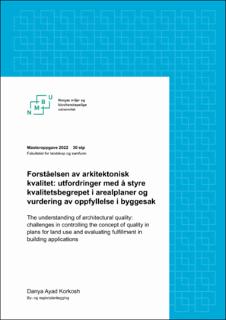| dc.contributor.advisor | Gunnar Ridderström | |
| dc.contributor.author | Korkosh, Danya Ayad | |
| dc.date.accessioned | 2023-02-15T17:27:12Z | |
| dc.date.available | 2023-02-15T17:27:12Z | |
| dc.date.issued | 2022 | |
| dc.identifier | no.nmbu:wiseflow:6726303:52487184 | |
| dc.identifier.uri | https://hdl.handle.net/11250/3051233 | |
| dc.description.abstract | Denne oppgaven tar for seg hvordan begrepet «arkitektonisk kvalitet» forstås av arkitekter, nasjonale policygivere og lovgiver. I tillegg til å undersøke hvilke elementer ved denne forståelsen som kan styres i plan- og bygningsloven (pbl.), forsøker oppgaven å avklare om det finnes rammer for hvordan krav til oppfyllelse av kvalitet i arealplaner skal vurderes i den enkelte byggesak.
Gjennom analysearbeidet har det blitt klart at det finnes både likheter og ulikheter blant de faglige aktørenes forståelse av kvalitetsbegrepet. Som lokal planmyndighet har kommunen anledning til å styre noen av disse elementene i juridisk bindende arealplaner, i medhold av pbl. Andre elementer vil bygningsmyndighetene kun ha mulighet til å vurdere i den enkelte byggesaken. Det er også noen deler ved begrepet som kommunen verken kan styre eller vurdere i eller i medhold av pbl.
Det er en utfordring at både arkitekter og nasjonale policygivere peker på at meningsinnholdet i begrepet ikke kan reduseres til enkeltelementer, samtidig som lovgivningen har manglende virkemidler for at plan- og bygningsmyndighetene kan styre eller vurdere helheten ved de faglige aktørenes forståelse. Dette er en relevant problemstilling, i det bestemmelser kan angi at et tiltak skal ha høy arkitektonisk kvalitet uten at det gis en nærmere redegjørelse for hva dette betyr. I praksis betyr dette at det vil være elementer ved kvalitetsbegrepet som er ment skal styres i arealplanen, men som det ikke er mulig å vurdere oppfyllelsen av i den enkelte byggesaken. Slik blir begrepsbruken dermed upresis, og fungerer som en inngangsport til tolkningstvil. | |
| dc.description.abstract | This master thesis examines how the term «architectural quality» is understood by architects, national policymakers and legislator. In addition to studying which elements of the quality term that can be controlled in or in accordance with the Planning and Building Act, the thesis clarifies whether there are frameworks for how the fulfillment of quality should be evaluated as a part of the building permit.
Through the analysis, it has become clear that there are both similarities and differences among the professional instances' understanding of the concept of quality. The municipality, as the local planning and building authority, can control some of these elements in spatial plans in accordance with the legislation. While other elements will only be evaluated by the building authorities, as a part of the building permit. There are also some parts of the term that the municipality neither can control nor evaluate in or in accordance with the Planning and Building Act.
It is challenging that both architects and national policymakers calls attention to the fact that the meaning of the term cannot be reduced to individual elements, while the legislation lacks tools that makes it possible to control or evaluate all parts of the understanding of architectural quality. This means that there is a possibility that the content the term is intended to contain, is not taken care of in the process from planning to implementation. This applies, for example, to a provision that a project must have good architectural quality, without a further explanation of what the meaning of the term is. The use of the term thus becomes imprecise and is as a gateway to interpretive doubts. | |
| dc.language | nob | |
| dc.publisher | Norwegian University of Life Sciences | |
| dc.title | Forståelsen av arkitektonisk kvalitet: utfordringer med å styre kvalitetsbegrepet i arealplaner og vurdering av oppfyllelse i byggesak | |
| dc.type | Master thesis | |
